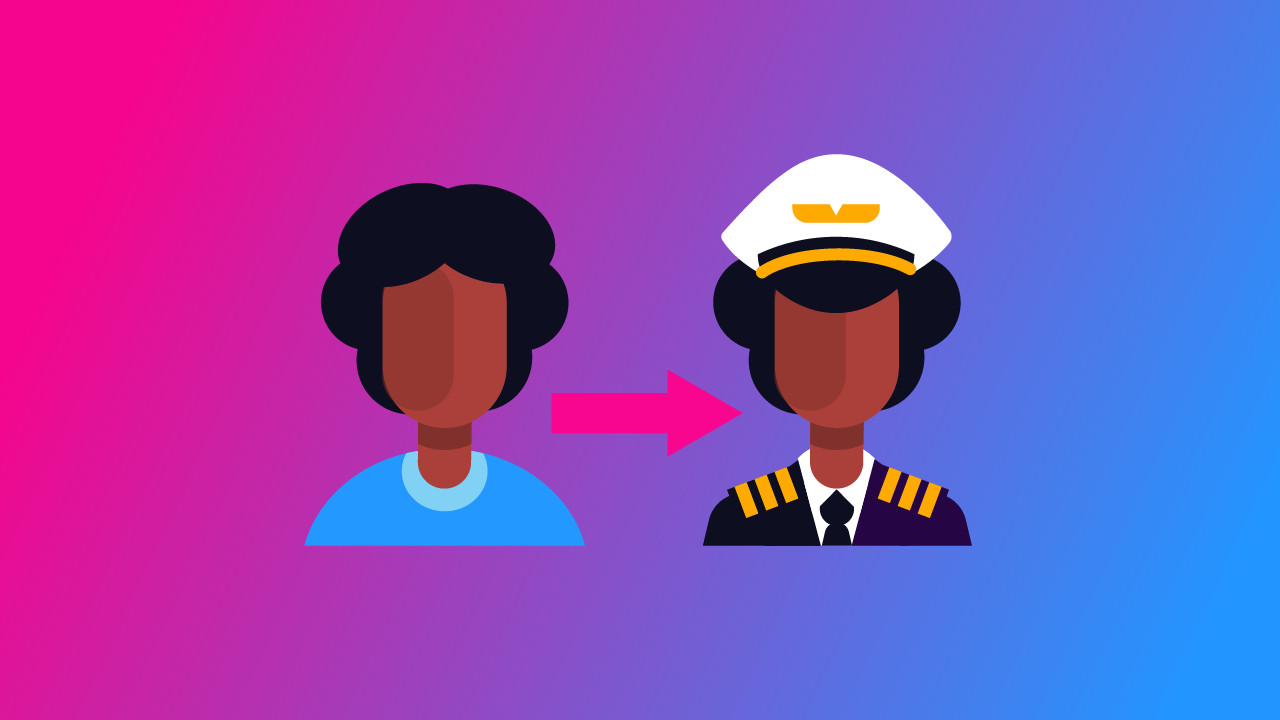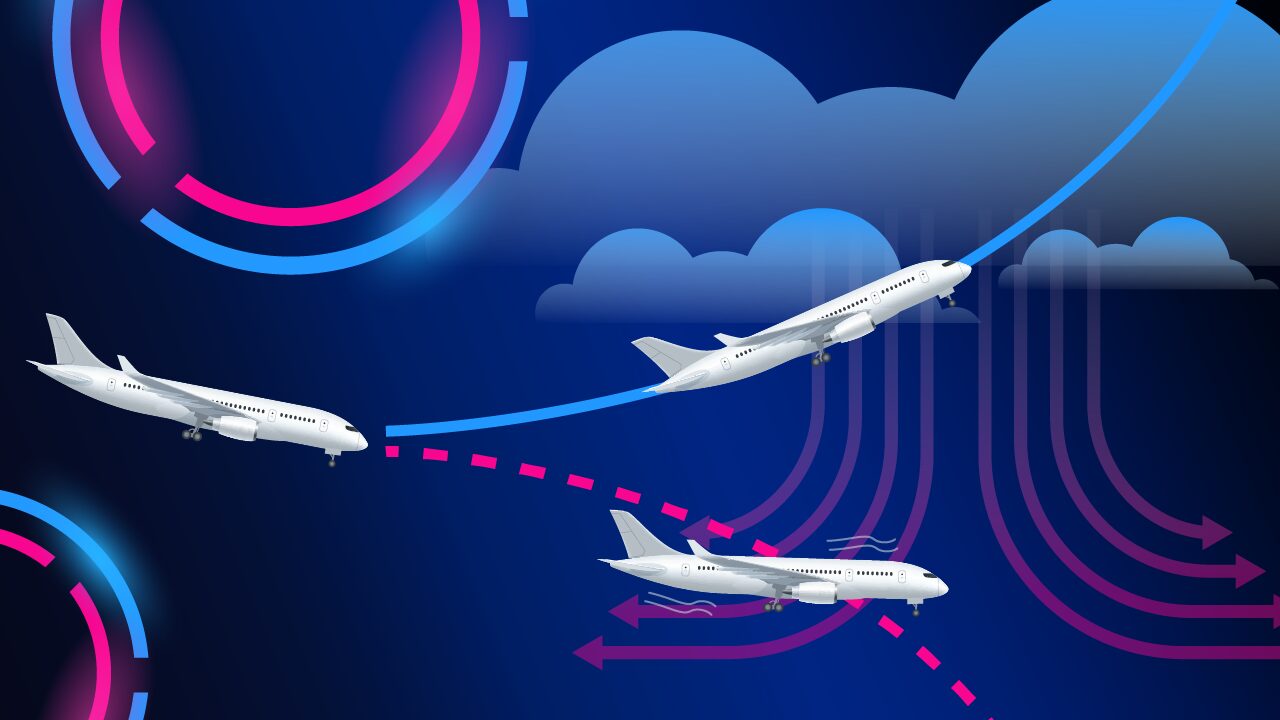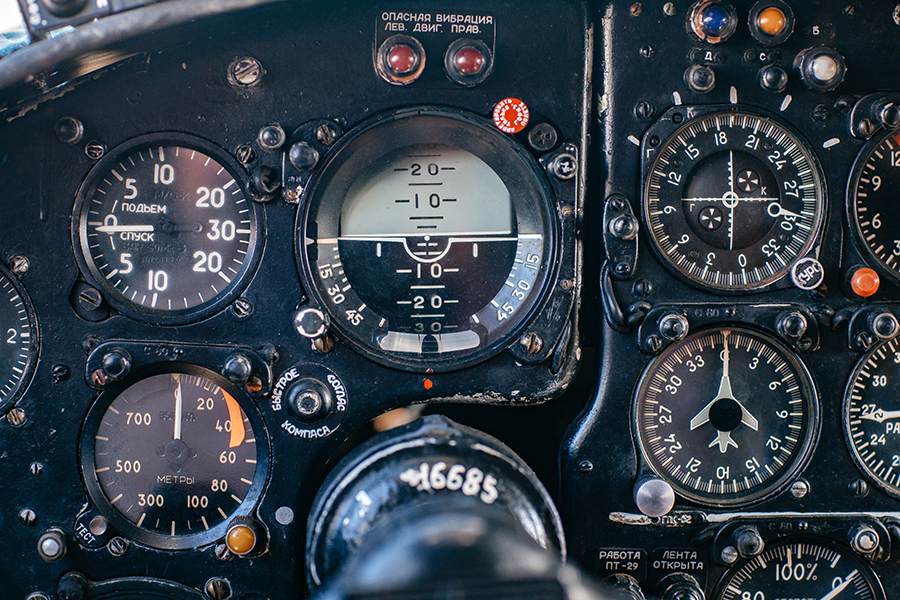-
Key Takeaways
-
Understanding the Different Types of Pilots
- Recreational vs. Private vs. Commercial Pilots
- Airline Transport Pilot (ATP)
-
Basic Requirements to Become a Pilot
- Age and Language Proficiency
- Medical Certificates
- BasicMed (Not for ATP/Airline Ops)
- Aeronautical Knowledge and Experience
-
Steps to Becoming a Pilot
- Step 1: Research Pilot Schools
- Step 2: Take an Introductory Flight
- Step 3: Obtain a Student Pilot Certificate
- Step 4: Secure an FAA Medical Certificate
- Step 5: Begin Ground and Flight Training Lessons
- Step 6: Pass the Private Pilot Knowledge Test
- Step 7: Complete Solo Flights
- Step 8: Pass the Private Pilot Practical Exam (Checkride)
-
Advancing Your Pilot Training
- Earning an Instrument Rating
- Adding a Multi-Engine Rating
-
Building Flight Experience
- Becoming a Certified Flight Instructor (CFI)
- Cadet Programs
- Other Ways to Build Flight Time
-
Financial Considerations
- Cost Breakdown of Pilot Training
- Financing and Scholarships
-
Choosing the Right Flight School
- Part 61 vs. Part 141 Schools
- Questions to Ask When Evaluating Schools
-
Career Pathways in Aviation
- Regional vs. Major Airlines
- Corporate and Charter Flying
- Continuing Education and Type Ratings
-
Conclusion
-
Sources
Have you ever looked up at the sky and pictured yourself at the controls of an aircraft?
Becoming a pilot may seem like a big dream, but you can achieve it with the right training and commitment.
Let’s chart your course and look at every waypoint in the journey. You’ll find various training paths and career options to help you succeed in the cockpit.
Heads up: Some links in this article are affiliate links. As an Amazon Associate, we earn from qualifying purchases. This helps support the site so we can keep creating content for readers like you.
Key Takeaways
- You start with a student pilot certificate, then work up to private, commercial, and airline levels.
- Each step has its own training, test, and health rules.
- Pick a school based on cost, location, and instructor quality.
- Getting more ratings and flight experience helps you grow as a pilot.
Understanding the Different Types of Pilots
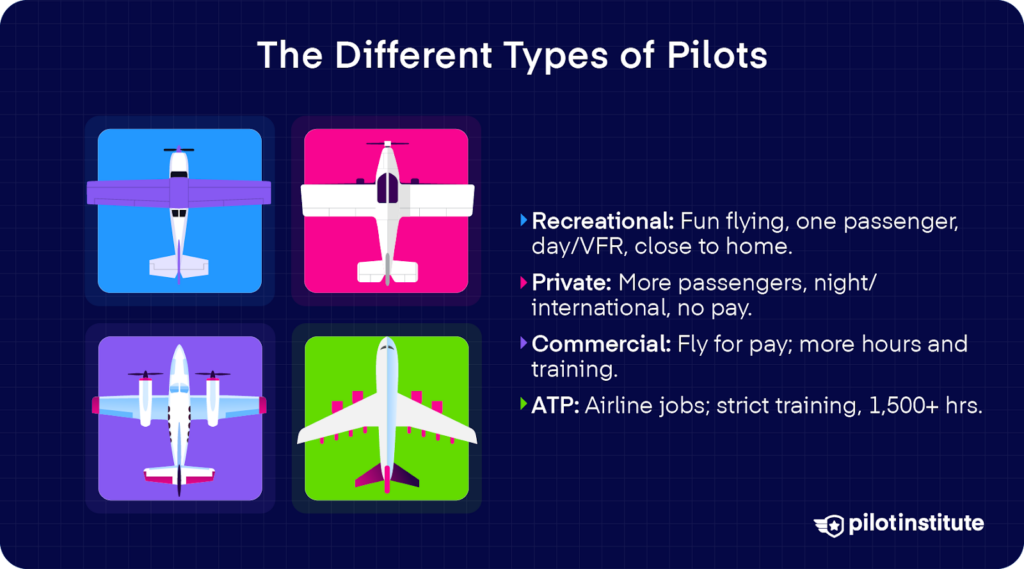
Recreational vs. Private vs. Commercial Pilots
You’ll explore various pilot certificates when you think about being a pilot. Each gives you different freedoms and carries different limits.
Let’s see how they build on each other, so you can decide which path matches your goals.
Recreational Pilot Certificate
A Recreational Pilot Certificate is for those who want to fly for fun. It comes with fairly strict rules.
What can you do with it?
- You may carry at most one passenger.
- You must stay within 50 nautical miles of your departure airport (unless you receive extra training).
- You must fly during daylight under good weather, not at night, in limited ATC-required airspace unless endorsed.
You won’t be able to fly at night or into airspace that requires full communications with Air Traffic Control (ATC), unless you get specific training and/or endorsements.
You also can’t be the Pilot In Command (PIC) of an aircraft that has more than four seats or more than one engine.
Private Pilot Certificate
Looking for more flight privileges? A Private Pilot Certificate gives you just that. You can fly larger or more complex aircraft, carry more than one passenger, and fly at night. You can even fly internationally (subject to foreign rules, of course).
The major limitation is that you can’t be compensated for your flying. But there are exemptions under very strict rules.
For example, under 14 CFR 61.113, you may fly for compensation if the flight is incidental to your business and the aircraft does not carry passengers or property for compensation or hire.
The training and testing are also more demanding than for recreational flying. You will need more hours in the cockpit and more ground study. You’ll also need to pass challenging written and practical tests.
But ultimately, all of that helps build a foundation if you later choose to go commercial.
Commercial Pilot Certificate
Once you move to a Commercial Pilot Certificate, you cross the threshold into being allowed to fly for pay. You can finally be compensated for flying people or cargo as long as you meet the rules for the operation.
Training gets tougher with more flight time, complex operations, and increased safety responsibilities.
Airline Transport Pilot (ATP)
Now, let’s talk about ATP (Airline Transport Pilot), the top level of pilot certification in the U.S.
Role and Responsibilities
An ATP certificate is required if you want to command scheduled airline operations. It’s also needed in many commercial operations beyond simple charters.
Your decisions and skills will be held to very high standards. The stakes will be bigger, so expect the training and regulations to be more intense.
Requirements for ATP Certificate
Here are some things you must meet to get an unrestricted ATP certificate.
- You must be at least 23 years old. There’s also a Restricted ATP (R-ATP) for younger or military pilots under certain conditions.
- Minimum 1,500 hours total flight time. This includes specific amounts of cross-country time, night flying, instrument flying, and being PIC in certain classes. You can have fewer hours with the R-ATP.
- You must hold a current FAA First-Class Medical Certificate to act in PIC for ATP operations.
- You must pass the FAA knowledge and practical test (checkride) at ATP standards.
What is it all for? The ATP certificate proves you’ve achieved the highest level of training and skill as a pilot.
It opens up the possibility to take on advanced commercial roles. But even more exciting, you’ll be able to command aircraft in airline operations.
Basic Requirements to Become a Pilot
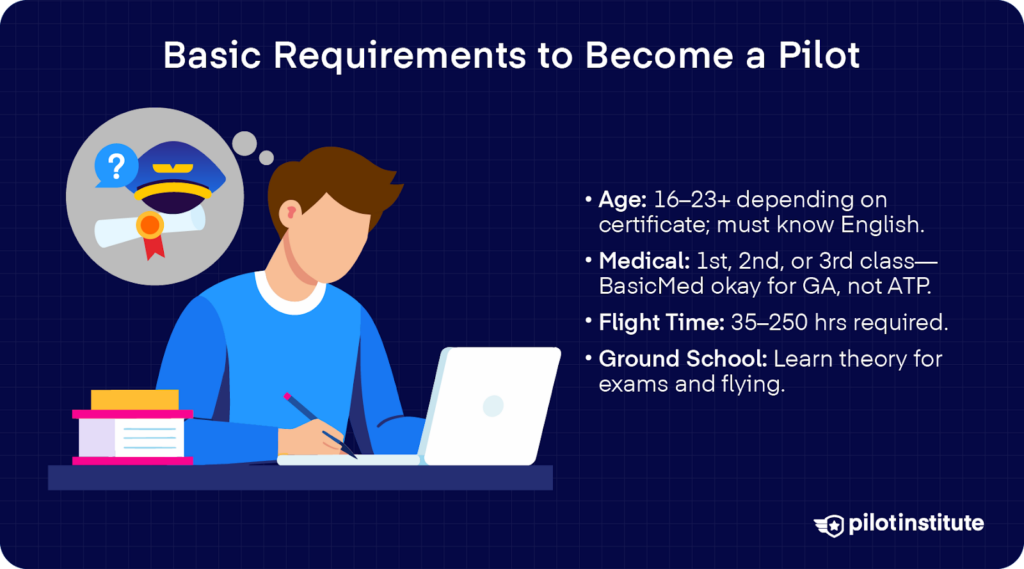
There will be requirements you’ll have to meet as you advance through your career. Every pilot has gone through them, and so can you!
Let’s talk about what it takes to become a certified pilot.
Age and Language Proficiency
Each step in pilot certification comes with an age requirement. You can start with a student pilot certificate at 16, or 14 if you’re training in gliders or balloons.
To earn a private pilot certificate, you must be 17, or 16 for gliders and balloons.
A commercial pilot certificate requires you to be at least 18. At the top level, an ATP certificate requires you to be 23, though an R-ATP is available at 21 under specific conditions.
Alongside age, all pilots must demonstrate English proficiency.You must be able to read, speak, write, and understand the language.
Why is this important? You’ll need to use English when communicating with ATC, reading charts, and coordinating with crew members.
Medical Certificates
An FAA Medical Certificate is another core requirement, but did you know it can come in three classes? They also have different validities depending on your license.
- The First Class Certificate is needed for full ATP privileges. It’s valid for 12 months if you’re under 40 and 6 months if you’re older.
- The Second Class applies to commercial pilots using commercial privileges. With a commercial pilot certificate, it will be valid for 12 months regardless of age.
- The Third Class Certificate is generally for student, recreational, and private pilots. It’s valid for 60 months if you’re under 40 and 24 months if you’re 40 or older.
You’ll submit your application through the FAA MedXPress website and complete your medical exam with an Aviation Medical Examiner (AME).
There’s one more certificate, but there’s a reason we didn’t include it in the list of the three classes.
BasicMed (Not for ATP/Airline Ops)
BasicMed is a way for some GA pilots to fly as PIC without an FAA medical. They must meet certain requirements to qualify. To use it, you must:
- Hold a valid U.S. driver’s license.
- Have held an FAA medical at any time after July 14, 2006.
- Complete a physical exam with a state-licensed physician using the FAA CMEC every 48 months.
- Complete an FAA-approved online course every 24 months.
Keep your CMEC and course completion certificate with your records.
BasicMed Operating Limits
PIC only; not for compensation or hire; aircraft authorized for no more than 6 occupants and max certificated takeoff weight ≤ 6,000 lb; operations within the U.S., ≤ 18,000 ft MSL, and ≤ 250 KIAS.
Why can’t you use BasicMed for ATP? BasicMed does not satisfy ATP privileges or airline operations. ATP privileges require a First-Class Medical; airlines and most commercial air carrier operations expect/require First-Class for PIC. Use First-Class if you’re pursuing ATP/airline flying.
What will you be checked on? Expect exams on your vision, hearing, medical history, and overall health.
Aeronautical Knowledge and Experience
Minimum Flight Hours
To earn a private pilot certificate under Part 61, you’ll need at least 40 hours of flight time or 35 hours under Part 141.
A commercial certificate raises the bar to 250 hours under Part 61. However, an FAA-approved Part 141 program has a more structured curriculum. It can reduce the minimum total flight time to 190 hours.
Ground Training
Ground school ties it all together. Here, you’ll study subject areas like:
- Aerodynamics
- Aircraft Systems
- Meteorology
- Navigation
- FAA regulations
These lessons prepare you for written exams. You’ll also get more context needed in the cockpit. The concepts you learn on the ground will become practical during your flights.
Steps to Becoming a Pilot

Step 1: Research Pilot Schools
Starting your journey to become an airline pilot begins with choosing the right flight school. So, which boxes should it check?
Always confirm that a school is FAA-certified, then weigh whether Part 61 or Part 141 training best fits your needs.
Beyond these, you should also think about location and reputation. If they have good flying weather, varied airspace, and proven graduate success, then place those schools higher on the list.
We should also talk about budget. And yes, affordability does matter, but you should prioritize quality training over which school has the lowest price.
Good news: did you know that there are training courses you can take online?
You can even take your ground school online, complete with instructor endorsement for your FAA exam. Some of them offer lifetime membership and access to study and support groups.
Pilot Institute offers a structured but engaging curriculum. This makes for an accessible, and therefore more effective, pilot education.
Step 2: Take an Introductory Flight
Once you’ve narrowed down schools, schedule an introductory or “discovery” flight.
What can you expect on the discovery flight? It begins with a pre-flight briefing covering flying basics and what you’ll do on the flight. Your instructor will likely handle takeoff, then they’ll let you try simple maneuvers in the air.
After landing, you’ll do a debrief where you’ll reflect on what felt exciting or challenging.
This first experience should help you discover if you’re comfortable in the cockpit and whether flying truly excites you.
You’ll get a close look at the school’s environment. It also helps you judge if the investment of time, money, and effort is worthwhile.
Step 3: Obtain a Student Pilot Certificate
So, you’ve made up your mind and you want to be a pilot. The next step? Obtain a student pilot certificate through the FAA’s IACRA system.
You’ll need this certificate for your first solo flight, which is a major milestone in training.
Step 4: Secure an FAA Medical Certificate
All pilots must be in good health to fly; the same goes for student pilots. You’ll need an FAA medical certificate obtained through an Aviation Medical Examiner (AME).
The AME could ask you about any past or current health issues, and we encourage you to be honest about them. You’ll also be checked on your vision, hearing, heart health, and overall fitness.
Step 5: Begin Ground and Flight Training Lessons
So, it’s time to begin training as a student pilot. Should you be excited? Nervous? Curious? To all of these, our answer is yes.
Flight training combines ground and flight instruction. In the air, you begin with climbs, descents, and turns. Then, you’ll progress to more advanced maneuvers and emergency procedures.
What will a typical session consist of? Just to give you a quick rundown, there’ll be a pre-flight briefing, then you’ll do your pre-flight aircraft inspection.
After that, it’ll be time to practice in the air with instructor feedback. Once landed, you’ll have a post-flight debrief to review your progress and set goals.
On the ground, you study the concepts that pilots apply in flight. You’ll often use simulations or interactive lessons.
The secret? Consistent practice. It helps you retain skills while building your confidence.
Step 6: Pass the Private Pilot Knowledge Test
After completing ground school, you’ll take the FAA written knowledge test. This is a foundational step before the many milestones ahead.
What should you expect on the knowledge test? You’ll face about 60 multiple-choice questions. They cover subjects like regulations, navigation, and aircraft systems. The time limit is 2½ hours.
You can only move forward in training after you pass the exam.
How can you prepare for the knowledge test? Study these:
Pilot’s Handbook of Aeronautical Knowledge
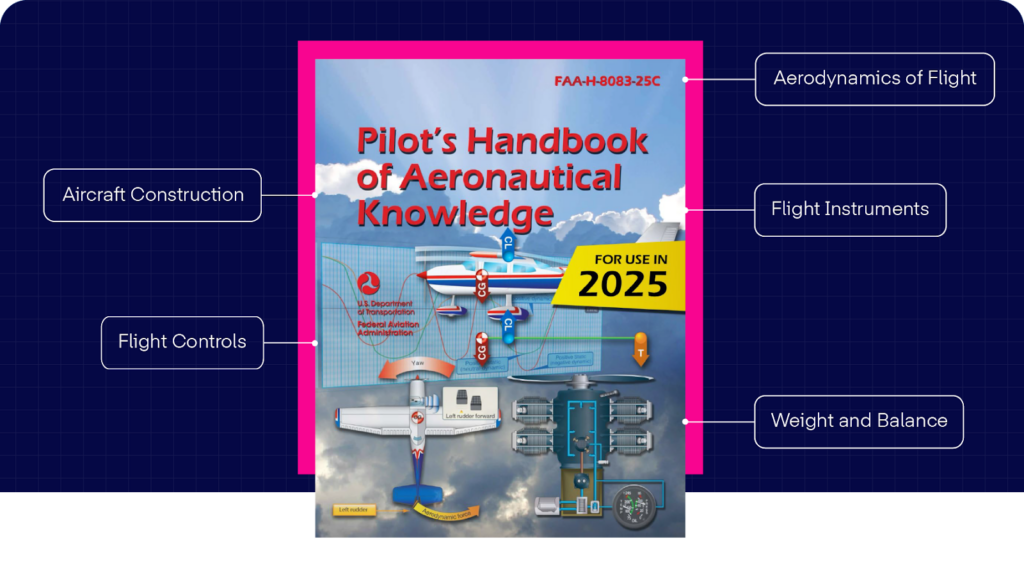
Affiliate disclosure: As an Amazon Associate, I earn from qualifying purchases.
You can use the Pilot’s Handbook of Aeronautical Knowledge in order to understand the underlying theory behind test questions.
| Resource | How can they help you get ready? |
| FAA Airman Certification Standards (ACS) guides | It shows exactly what topics will come up and how deeply you’ll be tested. |
| Practice exams and test prep resources | Interactive lessons prepare you for the knowledge test. Practice exams help you understand the exam’s format. |
A steady study routine will help a lot, especially if you focus on weaker areas.
Step 7: Complete Solo Flights
Solo flight is one of the most exciting milestones in training. But before flying alone, you must show proficiency in the different maneuvers during dual lessons.
Your instructor must judge you as a safe pilot before they sign off on your logbook endorsement. And once cleared, it’ll be time to fly solo.
We don’t want to spoil the experience, but know that the goal is to build your confidence and independence in flying. It’ll also strengthen your judgment and decision-making.
Step 8: Pass the Private Pilot Practical Exam (Checkride)
Your last hurdle before certification will be the checkride, or practical test. It has two parts: an oral exam and a flight test.
In the oral portion, a Designated Pilot Examiner (DPE) will ask you questions about the different flight training topics.
After that comes the flight test, it covers maneuvers, flight procedures, and emergencies. Everything you do will be measured against Airman Certification Standards.
How can you be ready for the practical test? It’s a good strategy to study the ACS and practice the required maneuvers. Do mock checkrides with your instructor to get a feel for the real thing.
You can supplement your checkride prep with online courses. Look for those designed by DPEs that will guide you through what to expect on exam day.
Advancing Your Pilot Training
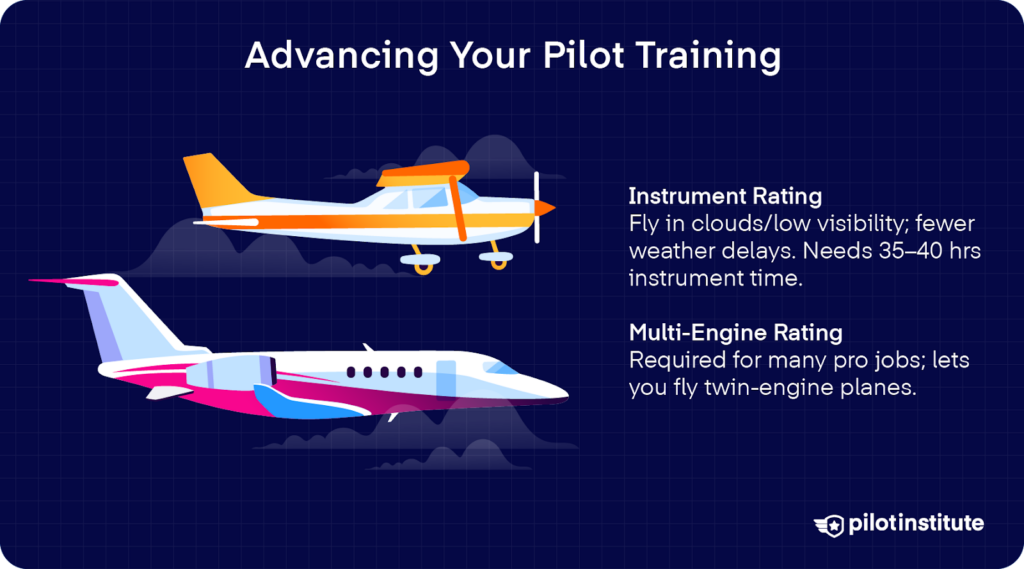
Earning an Instrument Rating
Getting an Instrument Rating (IR) is one of the biggest steps in becoming a more capable and confident pilot. But why is it so important?
With an IR, you can legally fly under Instrument Flight Rules. Clouds and low visibility will no longer be an obstacle. You’d get to enjoy fewer weather cancellations and greater flexibility.
It also sharpens your ability to handle the unexpected, since you learn to rely on instruments and navigation aids instead of just visual references.
How can you get instrument-rated? First, you must already hold at least a private pilot certificate or be applying for one at the same time.
Your training will involve both ground and flight instruction. You should already have your IR before obtaining your commercial pilot certificate under Part 141, where you’ll need at least 35 hours of instrument training. Under Part 61, you’ll need 40 hours.
Adding a Multi-Engine Rating
With a Multi-Engine (ME) Rating, you can fly aircraft with more than one engine.
But why does this rating matter? Many commercial or airline operations use multi-engine aircraft, and being ME-rated greatly boosts your chances of landing a job.
As you can imagine, handling a multi-engine aircraft is more complex. Training focuses on single-engine flying and emergency operations.
Building Flight Experience
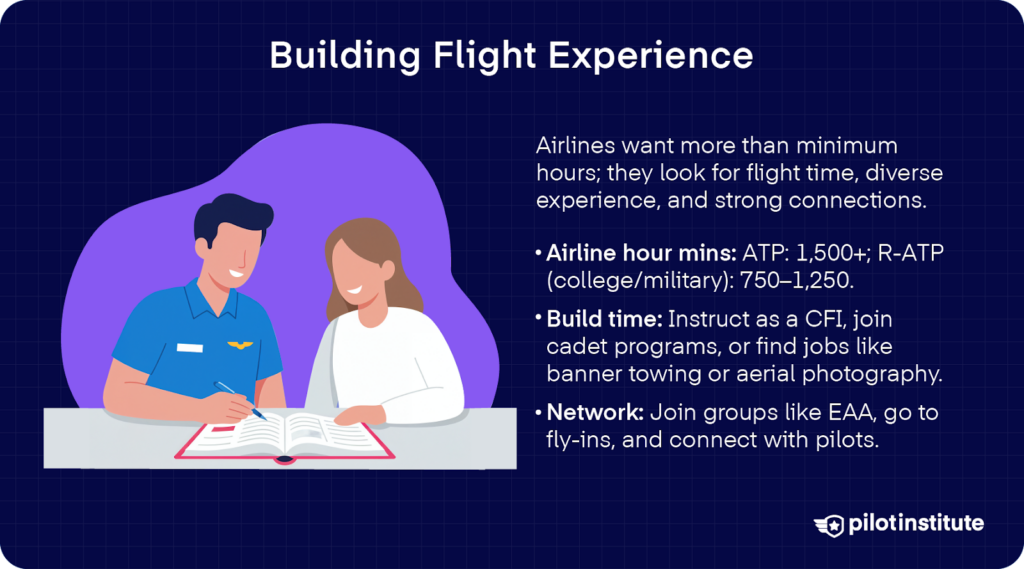
In case you don’t already know it, let us be the one to tell you this (harsh) truth: finding work as a pilot is going to take a whole lot more than the bare minimum, especially if you want to make it in the airlines.
A commercial pilot certificate does not necessarily guarantee a job. So, yes, while you may have met the required flight hours for your certificate, employers typically look for more.
“More,” in what sense? In flying hours, in experience diversity, and usually, in connections.
Here are the minimum hours for the airlines:
| Pathway | Requirements |
| ATP (Unrestricted) | 1,500 total hours, 500 XC, 100 night, 75 instrument, 250 PIC (incl. 100 XC & 25 night), min age 23 |
| R-ATP – Bachelor’s | 1,000 total hours, 200 XC, 100 night, 75 instrument, 250 PIC (incl. 100 XC & 25 night), min age 21 |
| R-ATP – Associate’s | 1,250 total hours, 200 XC, 100 night, 75 instrument, 250 PIC (incl. 100 XC & 25 night), min age 21 |
| R-ATP – U.S. Military | 750 total hours, 200 XC, 100 night, 75 instrument, 250 PIC (incl. 100 XC & 25 night), min age 21 |
Wondering about ways to collect these required hours? You can do so through various means, which we’ll cover.
Becoming a Certified Flight Instructor (CFI)
One of the most efficient ways to build flight hours and gain varied experience is to become a Certified Flight Instructor (CFI).
As a CFI, you can earn income by teaching while you’re building the flight time that future employers often want.
It’s a multifaceted role. You educate students in theory and practical skills, and you mentor them through their challenges and successes. Through every flight lesson, you’ll act as a safety advocate to your students.
Cadet Programs
Cadet programs can be another way to build time and follow a pipeline into the airline industry.
Here’s an overview of cadet pilot programs at the US’s largest airlines:
- American Airlines Cadet Academy: While not an offer of employment, American Airlines guarantees an interview with one of its regional carriers after completion of the cadet program.
- Delta Propel – Collegiate Pilot Career Path: The program leads to a job offer for successful candidates. The job could be flying aircraft for one of Delta’s connection carriers, the Air National Guard, or a job-share flight instruction position.
- Southwest Airlines Destination 225°: It offers a cadet, university, military, or employee pathway to gain the skills needed to become a Southwest first officer. However, it doesn’t guarantee employment even after successful completion of the program.
- United Airlines Career Path Programs: United guarantees an interview with one of its select United Express carriers. If hired, you’ll get to fly until you reach the required flight time to enter United’s hiring pool.
- JetBlue’s Gateway Select: They’ll make you a job offer once selected, contingent on the successful completion of the Program. You accrue flight hours working as an instructor with their partner, CAE.
Other Ways to Build Flight Time
Looking for another route? There are more ways to build hours that are less “linear” than instructing.
Check out openings in banner towing or aerial photography. Slowly but surely, these can help you accumulate flight time.
Employers often look for well-rounded pilots. Those hard, varied hours in your logbook make you stand out when they review your background.
Networking within the aviation community can open up all kinds of opportunities.
Where’s a good place to start? Join organizations such as the Experimental Aircraft Association (EAA). Attend fly-ins, airshows, and aviation conferences.
You’ll get to meet pilots and operators who could hire you, or connect you with someone who will.
Financial Considerations
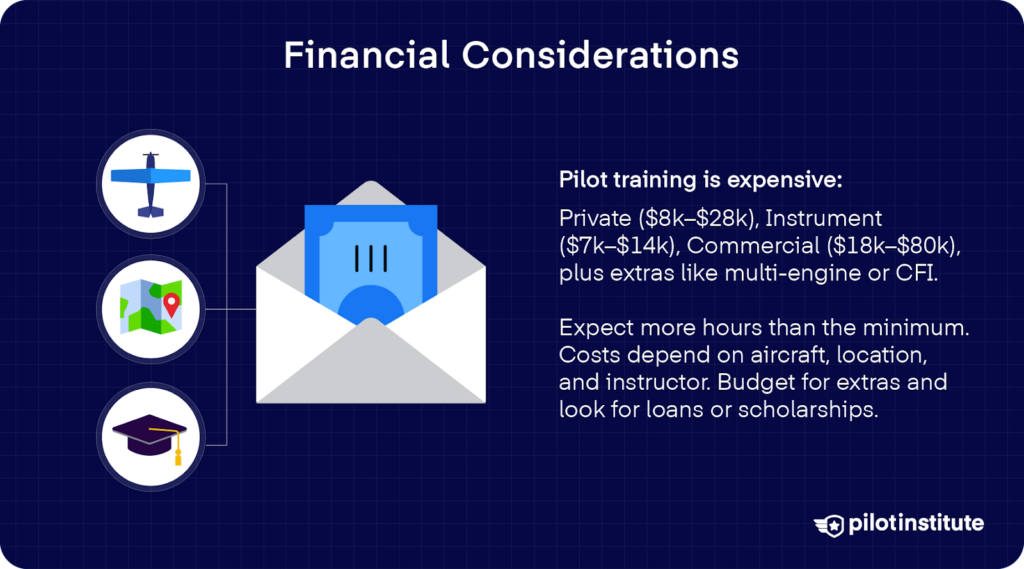
Training to become a pilot is expensive, and costs vary greatly depending on many variables. To give you an idea, here are some recent estimated cost ranges for different certificates and ratings in the U.S.
Cost Breakdown of Pilot Training
For a Private Pilot Certificate, many flight schools estimate between US$8,000 and US$28,000. An Instrument Rating often costs in the ballpark of US$7,000 to US$14,000.
For a Commercial Pilot Certificate (single engine), the cost might be around US$18,000 to US$80,000. It’ll depend on how much prior experience you already have and how many flight hours you need.
Adding a Multi-Engine Rating can cost several thousand dollars more. You can do a Commercial Multi-Engine Add-On costing about US$7,000.
Becoming a Certified Flight Instructor also has costs. School estimates vary widely, but they could be US$5,000 to US$11,000 or more.
| Course | Estimated Cost |
| Private Pilot | ~ US$8,000 to US$28,000 |
| Instrument Rating | ~ US$7,000 to US$14,000 |
| Commercial Pilot | ~ US$18,000 to US$80,000 |
| Muti-Engine Rating (Add-On) | ~ US$7,000 |
| Certified Flight Instructor | ~ US$5,000 to US$11,000 |
Additional Expenses
Take note that these are only ballpark figures that represent the cost of the minimum required training for certification.
Student pilot life comes with a lot of unknowns, but you can be ready for them. You should think about flight accessories, living expenses, exam fees, and additional flying hours.
Okay, should you seriously budget for extra flying hours? Yes.
Just look at real-world data. For example, although you only need 40 hours to get a private pilot certificate, students often take 75 hours on average before getting certified.
Factors That Affect Cost
The numbers also vary widely because a bunch of different factors can affect your final bill.
The type of aircraft matters, since newer or more complex models are more expensive to rent per hour. Where do you plan to fly? Urban areas or places where fuel costs run high often charge more.
Instructor fees vary, too. Experienced instructors or those in high-cost-of-living areas usually command higher rates.
Consistent lessons help you progress faster. You’d get to avoid costly repeat lessons, which is the real cost of spotty flight training. Extra simulator sessions and flight hours beyond the minimum (as we’ve warned) can add up quickly.
That said, it’s essential to be mindful of your budget. Make a detailed forecast that includes:
- Aircraft rental.
- Instructor fees.
- Exam fees.
- Cost of living (housing, transportation, food).
- Miscellaneous expenses (headset, flight computer, flight bag, insurance).
- Potential overruns (extra flight hours, emergencies, etc.).
Ask for transparent cost breakdowns. Financial planning helps avoid any nasty surprises, so your training can go smoothly.
Financing and Scholarships
Feeling discouraged? Don’t turn your back on flying just yet. There are many financing and scholarship options for you to explore!
Some lenders specialize in financing flight training. Also, if you’re enrolled in certain degree programs, student-loan programs may help.
Some flight schools offer payment plans or installment arrangements so you don’t have to pay everything up front.
There are various grants and scholarships, too. Check out Women in Aviation International, AOPA, or EAA. Military or government-sponsored training pathways could cover your training in exchange for service.
Some airlines also offer cadetship programs. If you get in, you’d receive financial support plus a pathway to an aviation job.
Choosing the Right Flight School
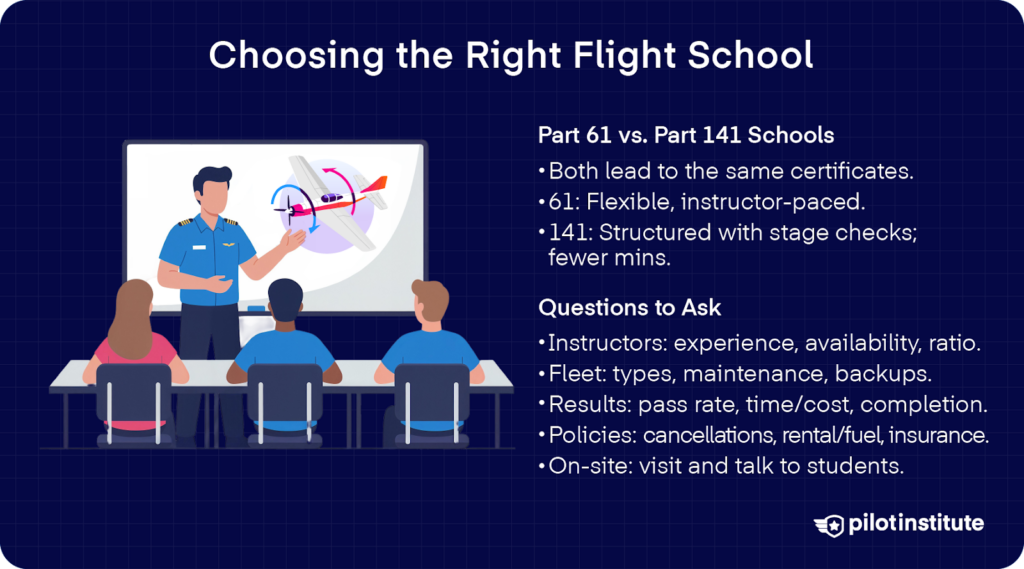
Part 61 vs. Part 141 Schools
When you start flight training, you’ll notice that schools usually operate under either Part 61 or Part 141 of the 14 CFR. Both paths lead to the same pilot certificates, but they differ in how the training is structured.
So, what’s the difference? Under Part 61, you get more flexibility. You can train on a schedule that fits around your life, and your instructor has room to tailor lessons to your pace.
Part 141, on the other hand, follows a strict FAA-approved syllabus with stage checks and milestones. But on the plus side, you can qualify with fewer minimum flight hours.
Questions to Ask When Evaluating Schools
Don’t hesitate to ask questions to decide whether a flight school is right for you. Ask about instructor qualifications: how experienced are they, are they full-time or part-time, and what is the student-to-instructor ratio?
Ask about the aircraft fleet. What type does the school use? How modern and reliable are they? Are they well-maintained? Does the school have backups to avoid delays?
Next, inquire about student success metrics. What percentage of students pass their checkrides on their first try? What’s the average time and cost to complete training, and how many students actually finish courses?
Also check school policies: cancellation and rescheduling policies, additional fees beyond tuition, aircraft rental, fuel, insurance, and any penalties.
You should visit schools and speak with current students if you can. It’s often the best way to learn a school’s strengths or issues you won’t read in a brochure.
Career Pathways in Aviation

Regional vs. Major Airlines
Many pilots start at regional airlines before moving up to the majors. Regionals fly shorter routes with smaller jets or turboprops, and they often give you faster chances to upgrade thanks to higher turnover.
Majors, on the other hand, run larger aircraft like Boeing 737s or Airbus A320s on domestic and international routes. Advancement is slower because seniority rules apply. That said, though, the pay and benefits are far better.
How can you move up? Build experience, maintain a spotless record, and expand your network.
Strong credentials keep you competitive when major airlines open their hiring windows.
Corporate and Charter Flying
Not every pilot flies for airlines. Many build careers in corporate or charter operations.
Corporate aviation often means flying executives in private jets. On the other hand, charter flying focuses on on-demand trips.
The lifestyle can be exciting, but also unpredictable. There’ll be last-minute calls and irregular hours.
The fun part? You’ll get to enjoy closer client interaction. And with that, strong customer service and professionalism will be just as important as your flight skills.
Continuing Education and Type Ratings
Your learning doesn’t end once you get your commercial or ATP certificate. You’ll need to keep up with the dynamic nature of aviation. You should continue training and proficiency programs to stay in the loop.
Have you ever heard of a type rating? It’s a specialized certification required to fly specific aircraft (beyond a certain weight or complexity).
To earn a type rating, you would undergo ground school tailored to that aircraft’s systems and operations, simulator training, and a practical test to demonstrate proficiency.
Once certified, you can operate that aircraft legally and safely, which only opens up more job opportunities!
Conclusion
Becoming a pilot is a journey that starts with curiosity. In time, it grows through discipline and persistence.
Every step builds the skills and confidence you need to succeed. Along the way, you’ll face challenges that test your resolve and celebrate milestones that fuel your ambition.
Wherever your destination may be, your path remains the same: through hard work and a passion for aviation that never stops growing.
Sources
See Sources
[1] 14 CFR 61.101 — Recreational pilot privileges and limitations. (n.d.). https://www.ecfr.gov/current/title-14/chapter-I/subchapter-D/part-61/subpart-D/section-61.101
[2] 14 CFR 61.113 — Private pilot privileges and limitations: Pilot in command. (n.d.). https://www.ecfr.gov/current/title-14/chapter-I/subchapter-D/part-61/subpart-E/section-61.113
[3] 14 CFR 61.133 — Commercial pilot privileges and limitations. (n.d.). https://www.ecfr.gov/current/title-14/chapter-I/subchapter-D/part-61/subpart-F/section-61.133
[4] 14 CFR 61.153 — Eligibility requirements: General. (n.d.). https://www.ecfr.gov/current/title-14/chapter-I/subchapter-D/part-61/subpart-G/section-61.153#p-61.153%28a%29
[5] 14 CFR 61.23 — Medical certificates: Requirement and duration. (n.d.). https://www.ecfr.gov/current/title-14/chapter-I/subchapter-D/part-61/subpart-A/section-61.23
[6] Guide for Aviation Medical Examiners. (n.d.). Federal Aviation Administration. https://www.faa.gov/ame_guide/app_process/general/classes
[7] Medical certification. (n.d.). Federal Aviation Administration. https://www.faa.gov/pilots/medical_certification
[8] 14 CFR §61.103 – Private pilot eligibility. https://www.ecfr.gov/current/title-14/part-61/section-61.103#p-61.103(c)
[9] 14 CFR §61.109 – Private pilot aeronautical experience (Part 61 minima). https://www.ecfr.gov/current/title-14/chapter-I/subchapter-D/part-61/subpart-E/section-61.109
[10] 14 CFR 61.129 — Aeronautical experience. (n.d.). https://www.ecfr.gov/current/title-14/chapter-I/subchapter-D/part-61/subpart-F/section-61.129
[11] 14 CFR Part 141, Appendix B – Private pilot curriculum & reduced minima. https://www.ecfr.gov/current/title-14/chapter-I/subchapter-H/part-141/appendix-Appendix%20B%20to%20Part%20141#p-Appendix-B-to-Part-141(4.)
[12] 14 CFR Part 141, Appendix C – Instrument curriculum & training hours. https://www.ecfr.gov/current/title-14/appendix-Appendix%20C%20to%20Part%20141#p-Appendix-C-to-Part-141(4.)
[13] 14 CFR Part 141, Appendix D – Commercial curriculum & reduced minima. https://www.ecfr.gov/current/title-14/chapter-I/subchapter-H/part-141/appendix-Appendix%20D%20to%20Part%20141
[14] FAA Airman Certification Standards (ACS), Private Pilot Airplane. https://www.faa.gov/training_testing/testing/acs/private_airplane_acs_6.pdf
[15] Flight Standards Service. (2023). Airline Transport Pilot and type Rating for Airplane Category Airman Certification Standards. https://www.faa.gov/training_testing/testing/acs/atp_airplane_acs_11.pdf .
[16] FAA Pilot’s Handbook of Aeronautical Knowledge (FAA-H-8083-25). https://www.faa.gov/regulations_policies/handbooks_manuals/aviation/faa-h-8083-25c.pdf
[17] IACRA – FAA application portal for airman certificates. https://iacra.faa.gov/IACRA/HelpAndInfo
[18] FAA Designee (DPE) Directory & practical test info. https://www.faa.gov/other_visit/aviation_industry/designees_delegations/individual_designees/dpe
[19] FAA FAQ: Hourly requirements for becoming a pilot. https://www.faa.gov/faq/what-are-hourly-requirements-becoming-pilot
[20] Scholarships (non-FAA): Women in Aviation Int’l; AOPA; EAA; VA GI Bill® education benefits. https://www.wai.org/scholarships , https://www.aopa.org/training-and-safety/students/aopa-flight-training-scholarships , https://www.va.gov/education/about-gi-bill-benefits/
[21] 14 CFR Part 68 — Requirements for Operating Certain Small Aircraft Without a Medical Certificate (eCFR). https://www.ecfr.gov/current/title-14/chapter-I/subchapter-D/part-68
[22] FAA BasicMed overview page (requirements, eligibility, course links, high-level limits). https://www.faa.gov/licenses_certificates/airmen_certification/basic_med
[23] FAA AC 68-1A — BasicMed advisory circular (details on occupancy/weight, 18,000 ft / 250 kt limits, U.S.-only). https://www.faa.gov/documentlibrary/media/advisory_circular/ac_68-1a.pdf
[24] 14 CFR §61.23(c)(3) — Using a U.S. driver’s license under BasicMed conditions. https://www.ecfr.gov/current/title-14/chapter-I/subchapter-D/part-61/subpart-A/section-61.23
[25] 14 CFR 61.31 — Type rating requirements, additional training, and authorization requirements. (n.d.). https://www.ecfr.gov/current/title-14/chapter-I/subchapter-D/part-61/subpart-A/section-61.31
